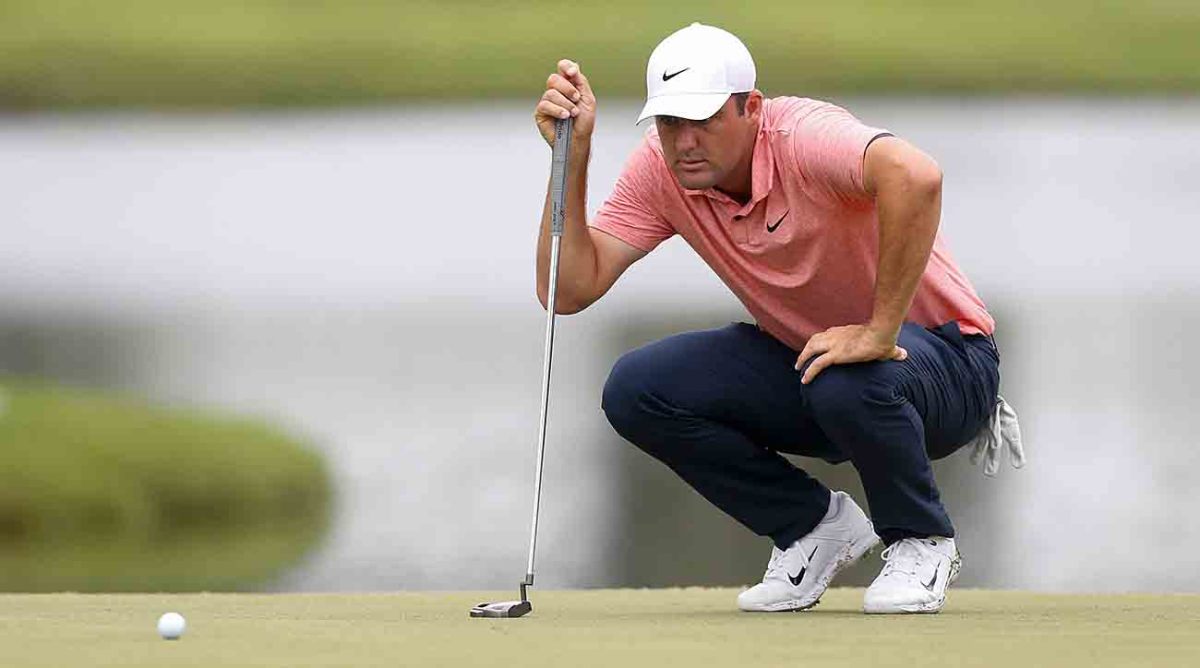Scottie Scheffler's Putting Woes Are Real, Just Don't Ask Him About Them

Scottie Scheffler’s putting woes have become the story that wouldn’t die, a persistent tale of trauma that doesn’t appear compatible with the immediate future. The Ryder Cup is a mere three weeks away. America’s top golfer has been fighting his flatstick in full public view since mid-May, a stretch that began with seven consecutive top-five finishes and featured some of the finest ballstriking in PGA Tour history.
All that tee-to-green brilliance only seemed to expose Scheffler’s shortcomings once he got there, however, leaving us to assess whether he’s a victim of precision or short of ammunition. Nobody on earth gets more good looks for birdie. Nobody can walk away with a 68 and feel like he left a few out there as often as the Sheriff, but Scheffler’s putting numbers across the board were alarmingly low in 2023—a staggering statistical oddity in that he has remained atop the Official World Golf Ranking (and SI World Golf Rankings) throughout those 3 ½ months.
Not that Scheffler doesn’t deserve to be No. 1. His high-level consistency is no less remarkable than his putting is lackluster. You want weird? The guy finished 37th on the Tour in birdie-conversion percentage but 134th in one-putt frequency, meaning a lot of his approach shots ended up too close to miss but anything beyond a kick-in was manual labor. From four to eight feet, Scheffler ranked 168th. From 10 to 15 feet, he was 160th.

When your best player turns a seven-footer on the right edge into a 52-yard field goal in December, you’ve got problems. The Ryder Cup is all about capitalizing on opportunities. If this U.S. roster was stacked from top to bottom, Scheffler’s deficiencies might not matter as much, but it isn’t, so they could. “I had back-to-back tournaments [in the spring] when I could have won but I putted poorly, and all of a sudden, it became this thing,” he said at the British Open.
“I’ll watch the highlights of my round, and even the announcers, any time I step over a putt, it’s like, ‘this is the part of the game he struggles with.’ You guys see me miss a 12-footer and [say] I’m struggling again.”
In many cases, these so-called media creations are indeed manufactured, but if the ball don’t lie, as it has been said, neither does the data it produces. Scheffler’s sensitivity on the matter is understandable. He’s a premium athlete performing at his sport’s highest level, enormously successful, and with that success comes a hardened competitive soul and bulletproof psyche, both of which are highly averse to any perception of inferiority. Especially from within.
The media has been an immensely popular target of guys like Scheffler since a medieval courier once pleaded to an unhappy recipient, “Please don’t kill the messenger!” Blame appropriation has been a predictable tactic for centuries; alpha males are primarily responsible for turning it into an art form. If anything, Scheffler’s fabulous 2023 was compiled despite such a glaring weakness in such a crucial part of the game. Queue the applause button, and when everyone’s done clapping, go give reality a great big hug.
The Sheriff had a shoddy season on the shortest grass. He underperformed to the extent where it might have cost him a couple of victories, but he still won twice, both of them premium-field triumphs, and still spent most of the year at No. 1. His putter tried to detain him but failed. Once again.
“I think I was probably viewed as a touch boring and didn’t really show much emotion, or whatever else you could think of,” Scheffler added at Royal Liverpool. “For a while, it didn’t seem like there was much of a story behind the way I play golf.”
Whether it’s coming from a sports psychologist, a swing coach or his grandmother, the vast majority of advice given to Scheffler would end up in the same drawer. Just ignore it all. It’s their job to stir up trouble. Most of us don’t get paid enough to engage in such journalistic tomfoolery, and besides, by all accounts, Scheffler is a very good man. Kind and considerate, appreciative and affable. If this were Patrick Reed or Bryson DeChambeau, a certain media bias might be easier to validate, but Scottie Scheffler?
No chance, smartypants. The putter can be an indispensable ally to those who don’t strike it as accurately as Mr. Numero Uno— an equalizer capable of salvaging shabby rounds and vaulting them into contention against those longer off the tee and sharper with their irons. For superstars such as Scheffler and Rory McIlroy, it’s a very different world, one in which the putter can act as a tool of betrayal. The expectations that accompany greatness create a burden far more tangible on the greens, where time slows to a crawl and the simplest of physical procedures yields a totally objective, cut-and-dried result.
You either make it or you miss it. A tour pro can whip out his driver and blast one 30 yards right of his intended destination, arrive at his ball and realize he’s just fine. The exacting standards of putting perpetuate a head game. Momentum shapes confidence, and without any positive mojo, you’re just another guy in the field.
Scheffler will overcome his struggles—everyone knows that. He is the complete package who has been winning golf tournaments by the bushel since he was a young boy. A player of whom very big things were expected, although his climb to No. 1 probably happened a lot quicker than most thought. With that in mind, he’s still just 27, barely removed from his first trip through the wash-and-rinse cycle, still learning how to handle all that fame and fortune with his feet on the ground and his head out of the clouds.
If pinning his difficulties on the people who cover golf for a living helps him master the process, that’s fine and dandy. Just another day at work for us, just another reason to believe for him. Maybe Scheffler will burn down the Euros with a scorching putter in Rome and carry the Yanks to that long-lost overseas victory. When he gets home, he can thank us for our help.
